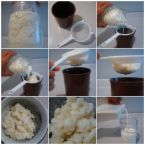1. Traditional process The traditional, or artisanal, method of making kefir is currently achieved by directly adding kefir grains (2-10%) to milk that has been pasteurized and cooled to 20-25¡C. After a period of fermentation lasting around 24 hours, the grains are removed by filtration. The beverage, itself containing live microflora from the grain, is then ready for consumption. The grains grow in the process of kefir production, and are reused for subsequent fermentations.
Grains can then be dried at room temperature and kept at cold temperature (4¡C). For a longer conservation, they can be lyophilized (freeze-dried) or frozen.
A second method, known as the"Russian method", permits production of kefir on a larger scale, and uses a series of two fermentations. The first step is to prepare the cultures by incubating milk with grains (2-3%), as just described. The grains are then removed by filtration and the resulting mother culture is added to milk (1-3%) which is fermented for 12 to 18 hours.
Several problems associated with traditional kefir have led to a more modern method of production. The traditional method produces only small volumes of kefir, and requires several steps, each additional step increasing the risk of contamination.
In addition, the grains themselves are not well understood, and are not well controlled. Strong pressure from the CO2 gas content can lead to the explosion of the recipient unless appropriate containers which resist the escaping of gas are used.
Finally, the shelf-life of traditional kefir is very short, less than three days.
2. Recent process To resolve the above difficulties, some producers in Eastern Europe have begun using concentrated lyophilized cultures made from grains. These mother cultures are then used as bulk starters for direct inoculation of the milk. More control over the process and fewer steps provide a more consistent quality.
3. Current areas of research Attention is now being turned toward producing kefir from pure, defined cultures.
This method will allow for a better control of the microorganisms involved, an ease of production, and a more consistent quality. The product will also have a longer shelf-life of 10 to 15 days at 4¡C. It will also permit various modifications of the product to achieve certain health or nutritional benefits.
Two basic procedures for manufacturing kefir have been developed using pure cultures isolated from kefir grains. Milk can be inoculated simultaneously with lactic acid bacteria and yeast, or it can undergo two fermentations, the first with lactic acid bacteria and the second with yeast. Results have been encouraging, but finding the right equilibrium of bacterial and yeast strains to create a product with the characteristic properties of traditional kefir including both the organoleptic qualities and the health benefits - is a difficult task. The major difficulty is understanding the microbiology of kefir.
Sunday, March 22, 2009
Subscribe to:
Post Comments (Atom)




No comments:
Post a Comment